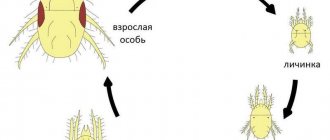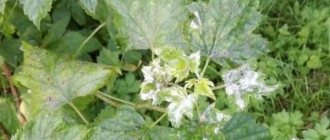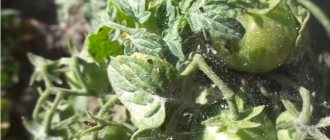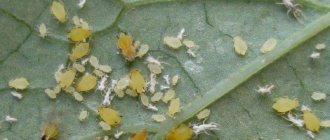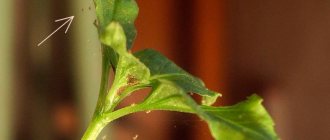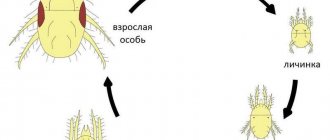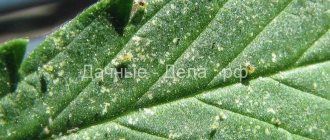Experienced gardeners know how quickly spider mites can destroy seedlings: sometimes days count. If the web is clearly visible, even chemicals may be powerless. Therefore, measures must be taken in advance.
We'll tell you how to deal with spider mites at home and what signs you can use to identify them. Let's talk about traditional methods and give tips on preventing damage.
What kind of pest is this?
Spider mites on tomato seedlings are a common problem in all climate zones. These are small arachnids, about 0.5 mm in size. Females are slightly larger, males are slightly smaller. They reproduce very quickly: females lay up to 20 eggs every day during their life (up to 4 weeks). During hot weather, hatching from the egg can occur within 3 days, and after 5 days the larva turns into a mature tick.
What kind of pest is this
The photo shows what spider mites look like on tomatoes.
Differences from other pests
Spider mites weave thick webs on tomato seedlings. These nasty-looking silk threads protect the colony of parasites from predators.
The enormous reproduction rate makes the mite less sensitive to pesticides, so conventional plant treatment may be ineffective. Unfertilized females are still capable of bearing offspring - their eggs hatch exclusively into males.
Mr. Summer Resident advises: preventive measures to prevent seedlings from becoming infected with spider mites
This pest can become a source of infectious diseases. The web protects it when sprayed, so it must be removed before the procedure. She gives shelter to other parasites. Fighting an infection is always more difficult than preventing it.
There are several methods that are used for preventive purposes:
- Disinfection: soil and seeds. You can freeze or steam the soil, or apply biological preparations.
- Spraying: with water or soap solution. The tick does not tolerate moisture, so treatment every 7 days will be an effective method.
- Weeding and trash removal. A mandatory procedure, because pests hibernate in them.
- Loosening. Prevents the development of parasites from eggs.
- Inspection. They are carried out constantly in order to detect and take the necessary control measures in time.
How does infection occur?
Spider mites on tomato seedlings can appear due to a number of reasons:
- adult parasites and their eggs are carried by the wind;
- ticks can travel by accidentally catching on the fur of animals, bird feathers, human clothing, and even the legs of large insects;
- parasites may be present in the soil and attack the seedlings as they begin to develop;
- Ticks can crawl from an infected bush to a healthy one.
These arthropods are most often brought into greenhouses by the wind or arrive with contaminated soil.
Use traditional recipes
Folk remedies - safe and inexpensive methods of dealing with ticks:
| Tar or laundry soap solution Grate about 100 g of soap. Dilute in hot water until completely dissolved. Add liquid to end up with about 2 liters of solution. Generously coat the plants on all sides . Also generously treat the soil under the stem and around the tomatoes so that the mite cannot move to other plants. | |
| Ethanol Apply alcohol to a cotton pad and moisten the tomatoes generously. Try not to miss a single section. It is better to work in the morning or evening, when the air is cooler and the composition evaporates more slowly. Repeat treatment every 3-5 days . This is due to the fact that the composition kills ticks, but does not destroy eggs, so application must be repeated to destroy young individuals | |
| Dandelion infusion 400 g of crushed dandelion, place in a bucket of water and leave for 3-4 hours. Strain the solution. Spray plants and soil . Repeat treatment once a week | |
| Infusion of garlic and dill Pour a kilogram of chopped dill into 5 liters of boiling water and leave for 4 hours. Strain and add 200 g of chopped garlic, leave for a day. Strain and spray the plants . Repeat treatment once a week | |
| Onion infusion Chop 200 g of onion and add a bucket of warm water. Leave for a day. Strain and add a little potassium permanganate so that the solution turns pale pink. Treat plants and soil with a sprayer . Repeat treatment every 3-4 days |
Signs of damage to tomato seedlings
Spider mites leave characteristic marks on tomato seedlings. It is impossible not to notice them. In case of severe infection, the half-dried plant is entangled in a cobweb, in which clusters of parasites scurrying back and forth are clearly visible.
Signs of damage to tomato seedlings
If the infection is mild, then signs of spider mite damage to tomato seedlings may be as follows:
- small dead areas appear on the leaves, damaged leaves gradually dry out completely and fall off;
- the leaves change color and a marble pattern may appear on them;
- on the leaves there are areas intertwined with thin cobwebs;
- leaves are deformed and curled;
- On the back of the leaves you can see small lumps that look like dust.
Seedlings affected by parasites may look quite healthy, but they will grow too slowly, and the buds will dry out and fall off.
Photos of spider mites on tomato seedlings give a good idea of what the consequences of the damage look like.
Signs and Symptoms of Plant Infestation
A plant infected with spider mites
At the initial stage, the small pest does not manifest itself in any way. During this period, you can only notice a thin silvery cobweb on the shoots and on the bottom of the leaves.
As the population of the colony increases, other signs of its presence are already visible.
- Brown spots appear on the leaves where they are punctured by a thin proboscis . These are dead tissues devoid of plant juice. They grow and merge into large formations.
- their secretions on the underside . They look like small black or rusty specks and are easily removed.
- Injured leaves begin to turn yellow , curl and dry out.
- Wilting affects young shoots and buds.
- The plant slows down its growth and development. In the stage of severe damage, it dies completely.
Why are spider mites dangerous on tomatoes?
The main danger is too slow development of seedlings, poor quality of the harvest, or complete death of diseased tomatoes. Even a mild form of infection will reduce yields by almost 20%.
But the trouble is that the spider mite is omnivorous. It parasitizes not only tomatoes, but almost all garden plants, fruit trees, roses, and melons. If you don’t fight it, you can quickly lose all the greenhouse and garden plants, as well as indoor flowers in the house.
Acaricidal drugs, their effectiveness and rules of use
To destroy spider mites, insecticidal preparations based on pyrethroids and organophosphorus compounds are used with sufficient success. Tetranychids are quite sensitive even to old (in terms of the date of development) and widespread substances - for example, malathion (karbofos), cypermethrin, chlorpyrifos, and therefore relatively inexpensive means can be used to combat them.
Thus, the most common means of combating spider mites include:
- Fitoverm is a drug based on aversectin C. It can be bought in different packaging, from 1 to 5 liters. The main distinguishing feature and advantage of Fitoverm is its rapid decomposition and inability to penetrate the internal tissues of plants. That is, seedlings treated with it will not accumulate insecticide, and within 2-3 days after spraying they will be free of “chemicals”. In addition, Fitoverm has a relatively low application rate, due to which even a large number of seedlings can be treated with a relatively small amount of product;
- Regular garden Karbofos or preparations based on the same active ingredient - Antiklesch, Bunchuk, Iskra M, Fufanon. Despite the fact that karbofos (aka malathion) has been used in agriculture for several decades, it continues to be effective in the fight against spider mites;
- Ditox is a product based on dimethoate, a representative of the class of organophosphorus compounds;
- Karate-Zeon is one of the most powerful drugs, the active ingredient of which is lambda-cyhalothrin. Highly toxic not only to tetranychids, but also to any other invertebrates (including ants, bees);
- Kinfos, containing two pesticides of different classes - the pyrethroid beta-cypermethrin and FOS dimethoate. Due to this, the likelihood of ticks becoming resistant to the product is almost zero;
- Clipper, the active substance of which is the pyrethroid bifenthrin. It poisons spider mites very quickly, but requires caution and safety precautions when used.
On a note
Some experts also indicate bitoxybacillin as an acaricide, a drug based on a culture of bacteria that causes digestive disorders in butterfly caterpillars and their starvation. Presumably, bitoxybacillin may have the same effect on ticks, but detailed studies in this direction have not yet been carried out.
To treat seedlings, it is sometimes advisable to use any inexpensive acaricidal agent available. In most cases, they quite effectively destroy spider mites and other possible pests on young plants. After treatment, you need to evaluate the result: if most of the mites died, but some remained alive, then it is enough to treat the seedlings with the same product again. If the ticks did not die at all, then you need to use a drug with a different active ingredient.
After the mites are destroyed, no further treatment of the seedlings is required. If at least some of the leaves remain intact, then the bush is highly likely to recover.
Leaves that are completely “beaten” by mites and are clearly drying out should be cut off and burned. This will allow you to protect untouched bushes and parts of an already affected plant from re-infestation by pests if some of them survived in dry leaves.
Reasons for appearance
Spider mites of all types (and there are several hundred of them) are extremely common. The most favorable conditions for their rapid development are dry, hot weather. If the air in a greenhouse warms up above 25°C and the humidity is too low, this creates an increased risk of plants becoming infected with mites.
Insufficient watering of seedlings, lack of humidifiers, intense heating - all this helps the survival and development of single eggs that may end up in the soil or penetrate into the greenhouse with the air entering it.
Reasons for appearance
The photo shows what signs of spider mite damage look like on tomatoes.
Preventive measures
Prevention will prevent the appearance and reproduction of spider mites. The most effective activities:
- maintaining temperature conditions and maintaining humidity levels;
- clearing the area of weeds;
- strengthening the immune system;
- compliance with crop rotation;
- disinfection of greenhouses using sulfur bombs;
- digging up soil and treating with acaricidal agents;
- moderate watering;
- regular cleaning of the greenhouse;
- planting pest-resistant varieties.
What means of struggle do you prefer?
ChemicalFolk
Fighting methods
You need to start fighting spider mites on tomato seedlings at the first sign of infestation. The struggle will be long, stubborn and multi-stage. It is impossible to get rid of a tick quickly. Its microscopic eggs are invisible to the eye and have amazing survival rates. Therefore, the life cycle of the parasite resumes at every opportunity.
Features of the fight against mites on tomatoes in a greenhouse
Spider mites are not insects, but arachnids. Therefore, all drugs for controlling insects in greenhouses in this case do not give the desired effect. Only those drugs are suitable whose packaging indicates that they have an acaricidal effect.
Taking into account temperature when processing plants
If a spider mite appears on tomatoes, then in addition to adults, eggs are also present, and they are not afraid of any poison. Therefore, treatment must be carried out in several stages and taking into account the ambient temperature.
The first stage kills ticks and their larvae, the second - larvae that have just hatched from eggs. The timing of hatching depends on the ambient temperature, so the interval between treatments should be as follows:
- at 20°C - 10 days;
- at 25°C - 5 days;
- at 30°C - 3 days.
At 18°C and below, treatment with poisons is not carried out at all, since mites stop their development.
How can plants be treated?
There are many ways to protect plants from arachnid parasites:
How can plants be treated?
- chemical preparations for killing ticks;
- predatory insects and arachnids that feed on spider mites;
- biological products that cause the death of ticks;
- folk remedies that reduce the activity of parasites.
To prevent recurrence of infection, it is necessary to improve soil hygiene, maintain temperature conditions and watering schedules.
Chemicals
If spider mites appear on tomato seedlings, then you need to start fighting them as early as possible. Special preparations are intended for anti-mite treatment of plants. They are divided into 2 groups:
- Acaricides are specialized chemicals for killing various types of ticks (Aktellik, Sunmite, Fufanon).
- Insectoacaricides are broad-spectrum chemicals that kill both insects and mites (Actellic, Vertimek, Lirum.
Conventional insecticides against arachnids (which include mites) are ineffective.
Advantages and disadvantages of using chemicals
The chemicals are easy to use, provide a prolonged effect, and are capable of mass destruction of various types of pests. The most potent ones can kill both adults and eggs. They are highly effective and have a clear application schedule.
The chemicals are very toxic and pose a health hazard to people, pets, and birds. They are destructive to bees, butterflies, dragonflies and other beneficial and rare insects. There is a danger that chemicals will accumulate in the soil. High-quality drugs are quite expensive.
Biological methods of control
Control by biological methods gives good results with weak and moderate infestations. Biological products destroy various types of pests (ticks, insects, nematodes), but they are not dangerous for people.
Biological methods of control
"Fitoverm" is one of the popular broad-spectrum drugs. It is based on the substance aversectin-C, which is obtained from fungi belonging to the streptomycete family. This substance causes paralysis in ticks that eat leaves treated with it, and they die after a few days. Parasites are not accustomed to this poison.
Also, such biological products as “Kleschevit”, “Aversectin”, “Akarin”, “Avertin” are based on this substance.
Traditional methods
Spider mites have been damaging vegetable gardens and orchards since time immemorial, so the arsenal of folk remedies for combating them is very rich. They are not very effective, but they do not pose any danger to the environment. If you use them in the early stages of infection or for prevention, then mites will not cause damage to the crop.
Laundry soap
Only the plants themselves need to be treated with soapy water. There is no need to water the ground with it or sprinkle it with soap powder.
The solution is prepared according to the following scheme:
- For every liter of water you need to take 100 g of ordinary laundry soap.
- It is first grated, then poured with very hot water and stirred until the soap shavings are completely dissolved.
- When the solution has cooled to room temperature, apply it liberally to tomato leaves.
- After the liquid has dried, water is sprayed onto the seedlings to wash away the soapy film.
After a few days, the procedure is repeated to destroy new larvae that hatched from the eggs that survived the treatment.
Garlic
Garlic solution does a good job of healing seedlings and preventing pests from multiplying.
Traditional methods
Ingredients for the solution:
- water - 10 liters;
- garlic - 30 g.
The cloves are peeled and passed through a press (or chopped as finely as possible). Pour the garlic mass with water, stir and let it brew for 24 hours. Then the liquid is filtered through a sieve and the tomato bushes are sprayed with the solution.
Also, the medicinal solution can be made from a concentrate. The proportions for the concentrate are as follows:
- water - 3 liters;
- garlic - 0.5 kg.
Garlic passed through a press (or crushed) is poured with water and infused for 5 days, then filtered. To treat plants, 30 ml of concentrate is dissolved in 10 liters of water.
Onion peel
Parasites cannot stand onion broth. It is prepared as follows. Pour 200 g of peel (onion can be of any type) into 5 liters of water, bring the mixture to a boil and leave to cool at room temperature for 12 hours. The leaves are filtered and treated with infusion.
Makhorka
You can also make a “treat” for spider mites from shag. The composition is as follows:
- water - 10 liters;
- shag - 100 g;
- laundry soap - 25 g.
Mahorka is added to water and infused for 24 hours. Then the container with the mixture is placed on the stove and brought to a boil. Remove from heat, cool and strain.
Makhorka
The soap is grated, poured with infusion, dissolved, and the resulting liquid is treated with plant leaves.
Henbane
Anti-acarid liquid can be prepared from fresh flowering black henbane. But this must be done with extreme caution, since henbane is a highly poisonous plant.
Ingredients:
- water - 7 liters;
- henbane plants (during the flowering period) – 3 kg.
Water is poured into a large saucepan, plant materials are loaded into it, placed on the stove and brought to a boil. Cool, filter and treat the tomato bushes with liquid.
If, when working with henbane, unusual thirst occurs, the mucous membranes of the mouth or eyes appear dry, you feel nervous excitement, and it becomes difficult to swallow, then you should urgently call an ambulance.
Alcohol
Anti-mite treatment of tomatoes is carried out with undiluted medical alcohol during hot, dry weather. Under these conditions, the alcohol has time to evaporate from the leaves before it burns them.
Ammonia
Unlike medical ammonia, ammonia must be diluted with water. The optimal ratio: take 30 ml of ammonia for 10 liters of water.
The treatment is carried out immediately after preparing the solution, since ammonia quickly evaporates and its concentration drops.
Taking into account temperature when processing plants
The instructions for a number of acaricides state the need for double treatment with the drug. And if you use an acaricide that does not affect pest eggs, you cannot neglect this recommendation. It is necessary to destroy not only adult individuals, but also the future generation, which will soon emerge from the eggs.
At the same time, the interval between treatments in the instructions is given conditionally, while it directly depends on the air temperature. Indeed, with different indicators, the rate of appearance of offspring will be different:
- at a temperature of +20 °C, the interval between treatments is 10 days;
- at +25 °C interval 5 days;
- at +30 °C interval 3 days.
At temperatures below +18 °C, spraying is ineffective, since the active phase of the pests’ life activity is suspended, and they hibernate, hiding in shelters.
Prevention
To prevent the appearance of such a difficult pest as spider mites, you need to regularly carry out preventive measures.
All debris and dead parts of plants must be promptly collected and thrown away from the soil surface.
Prevention
Twice a year, treat the soil with chemicals or water it with hot water.
In the fall, after harvesting the greenhouse, it is necessary to carry out general cleaning with thorough treatment of all surfaces and all garden tools.
The seedlings are carefully examined before planting, and if spider mites are found on the tomatoes, they are discarded (the photo shows the most characteristic signs).
When planting in the ground, they try to make a sufficiently large distance between the bushes.
Fertilize the soil, following the measure and recommendations for applying fertilizers (the appearance of mites is facilitated by an overdose of nitrogen-containing agents and a lack of phosphorus-containing agents).
How to detect a pest
The dimensions of spider mites are very small (up to 1 mm). This makes it impossible to detect it immediately after its appearance. In addition, it hides on the underside of the tomato leaf, feeding on the sap of the plant. You can identify the appearance of spider mites by the appearance of the fetus:
- discolored areas and white spots on the leaves become noticeable, the color of which becomes uneven over time;
- black dots appear on discolored areas of the leaf;
- the leaf blades gradually curl with their edges up, begin to dry out and fall off;
- a fine web is noticeable, enveloping parts of the plant and the fruits themselves.
Resistant tomato varieties to spider mites
There are no tomatoes that are completely immune to mites. But some varieties still have increased resistance, and even with minor damage they maintain productivity. These include:
- Sevruga is large-fruited and well suited for greenhouses and open ground.
- Marmande - early ripening, fleshy, unpretentious, hardy.
- Roma is mid-season, juicy, meaty.
These varieties are less affected by mites and reduce the risk of the parasite appearing in the greenhouse and garden.
Reviews from gardeners
Alla, Chernigov
Pour a little more than half of water into a liter jar, sprinkle Dichlorvos into it a couple of times, cover with a lid and stir, spray the plant, and water with the rest.
Source: forum.prihoz.ru
Vadim, Astrakhan
Apply the drug BI-58 New 10-15 ml per 10 liters of water. It has pronounced systemic properties, that is, if the entire area of the sheets is not treated, then the mite, biting into the sheet, still dies, because the drug moves with the juice. I have seen enough ticks in dozens of hectares. Proven method.
Source: dacha.wcb.ru
Tips and tricks
A few recommendations from experienced gardeners.
- If small parts of plants are affected, they must be removed immediately along with the parasites. There will be no great harm to the pepper, but the spread of the mite will be significantly reduced.
- At the initial stage of infection, you can manually remove the parasites or wash them off with soap and water.
- To increase resistance to parasites, you need to increase the immunity of peppers. For this purpose, stimulants are used, for example, “Immunocytophyte”, “Carvitol”.
- Foliar phosphorus-potassium fertilizers increase resistance to mite infestation.
How to breed in greenhouses and conservatories
For large premises - greenhouses, conservatories, winter botanical gardens, infestation with insect pests means the gradual death of all plants, since mites spread at an enormous rate.
Scientists who have studied the problem of pest prevention believe that the fastest and safest method is biological destruction, that is, the use of natural enemies.
Predatory individuals are released onto the affected areas and quickly deal with the prey. According to research, using this method at home is unprofitable. 2 – 3 flowers can be treated with herbal remedies.
If it is not possible to order natural enemies, you can equip the room with ultraviolet lamps and turn them on periodically. Ultraviolet light destroys eggs.
Types of insects
There are several types of pests:
- Ordinary. Females of this species are usually larger than males. Color ranges from greenish-yellow to green-brown. Lives everywhere except the cold poles. Omnivorous.
- Red spider mites. Omnivorous pests, but in cold regions they can survive only on indoor plants.
- Atlantic view. Most dangerous for cucumbers, citrus fruits and palm plants.
- Turkestan. Settles on ornamental and agricultural crops.
- Red-footed.
- Savzdarga.
- Cyclamen - loves poisonous cyclamens, which is why it got its name. Can eat geranium and balsam.
- False - does not spin a web, so it is difficult to detect.
- Wide - found only on indoor plants. Can be found on cacti and citrus trees.
- Flathead or flathead. Eats citrus fruits and any type of succulents.
- Clover - found on cereal crops, but can harm indoor plants.
about 1,300 species in nature but the methods of controlling spider mites are almost the same.

